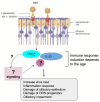SARS-CoV-2 and Other Respiratory Viruses in Human Olfactory Pathophysiology
- PMID: 38543591
- PMCID: PMC10974907
- DOI: 10.3390/microorganisms12030540
SARS-CoV-2 and Other Respiratory Viruses in Human Olfactory Pathophysiology
Abstract
Acute respiratory viruses (ARVs) are the leading cause of diseases in humans worldwide. High-risk individuals, including children and the elderly, could potentially develop severe illnesses that could result in hospitalization or death in the worst case. The most common ARVs are the Human respiratory syncytial virus, Human Metapneumovirus, Human Parainfluenza Virus, rhinovirus, coronaviruses (including SARS and MERS CoV), adenoviruses, Human Bocavirus, enterovirus (-D68 and 71), and influenza viruses. The olfactory deficits due to ARV infection are a common symptom among patients. This review provides an overview of the role of SARS-CoV-2 and other common ARVs in the development of human olfactory pathophysiology. We highlight the critical need to understand the signaling underlying the olfactory dysfunction and the development of therapeutics for this wide-ranging category of AVRs to restore the altered or loss of smell in affected patients.
Keywords: COVID-19; anosmia; loss of smell; olfaction disorders; respiratory viruses.
Conflict of interest statement
The authors declare no conflict of interest.
Figures




Similar articles
-
Smell loss associated with SARS-CoV-2 is not clinically different from other viruses: a multicenter cohort study.Rhinology. 2024 Feb 1;62(1):55-62. doi: 10.4193/Rhin23.116. Rhinology. 2024. PMID: 37772802
-
The disappearance of respiratory syncytial virus and influenza viruses in children during the second year of the COVID-19 pandemic - are non-pharmaceutical interventions as effective as vaccines?Eur Rev Med Pharmacol Sci. 2023 Apr;27(8):3777-3783. doi: 10.26355/eurrev_202304_32178. Eur Rev Med Pharmacol Sci. 2023. PMID: 37140326
-
High prevalence of SARS-CoV-2 and influenza A virus (H1N1) coinfection in dead patients in Northeastern Iran.J Med Virol. 2021 Feb;93(2):1008-1012. doi: 10.1002/jmv.26364. Epub 2020 Aug 13. J Med Virol. 2021. PMID: 32720703
-
Olfactory dysfunction as a post-infectious symptom of SARS-CoV-2 infection.Ann Med Surg (Lond). 2022 Mar;75:103352. doi: 10.1016/j.amsu.2022.103352. Epub 2022 Feb 11. Ann Med Surg (Lond). 2022. PMID: 35169465 Free PMC article. Review.
-
The effect of coronaviruses on olfaction: systematic review.Rhinology. 2021 Jun 1;59(3):226-235. doi: 10.4193/Rhin20.610. Rhinology. 2021. PMID: 34091654
Cited by
-
Bacterial and Viral Co-Infections in COVID-19 Patients: Etiology and Clinical Impact.Biomedicines. 2024 Sep 27;12(10):2210. doi: 10.3390/biomedicines12102210. Biomedicines. 2024. PMID: 39457522 Free PMC article.
References
-
- Hui D.S., Azhar E.I., Madani T.A., Ntoumi F., Kock R., Dar O., Ippolito G., McHugh T.D., Memish Z.A., Drosten C., et al. The continuing 2019-nCoV epidemic threat of novel coronaviruses to global health—The latest 2019 novel coronavirus outbreak in Wuhan, China. Int. J. Infect. Dis. 2020;91:264–266. doi: 10.1016/j.ijid.2020.01.009. - DOI - PMC - PubMed
Publication types
LinkOut - more resources
Full Text Sources
Miscellaneous

